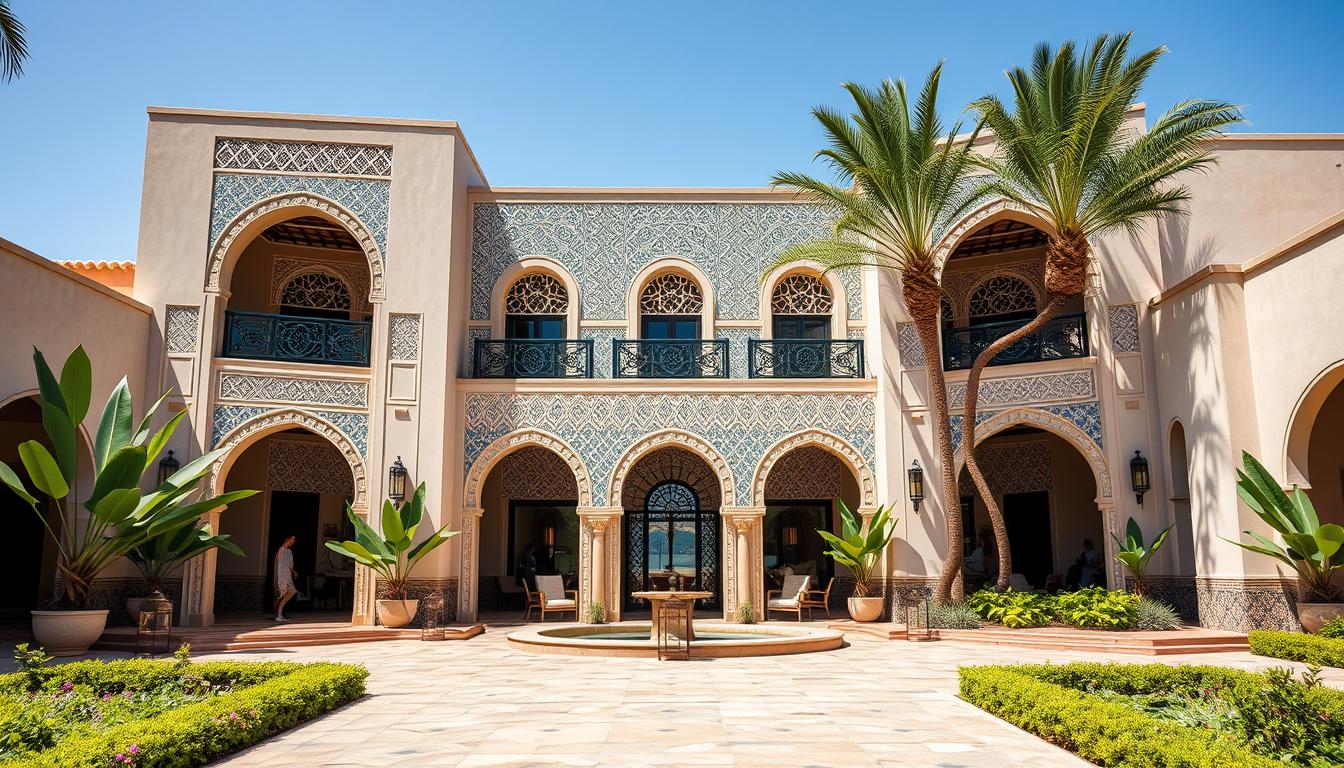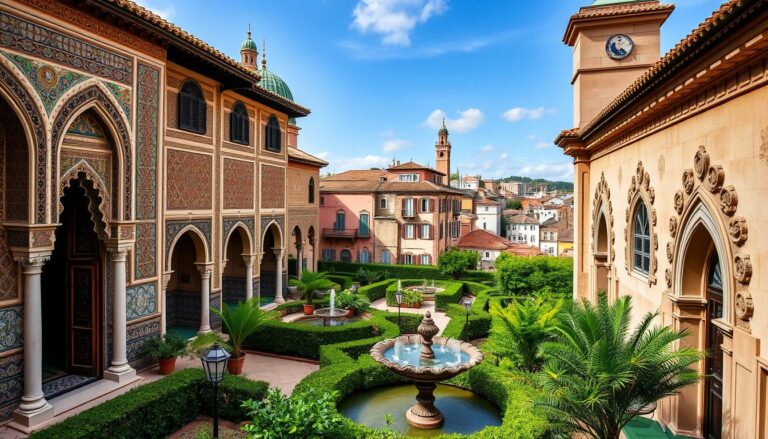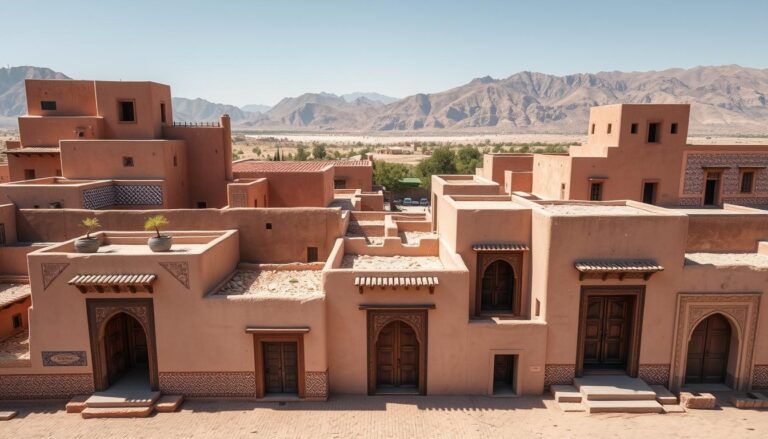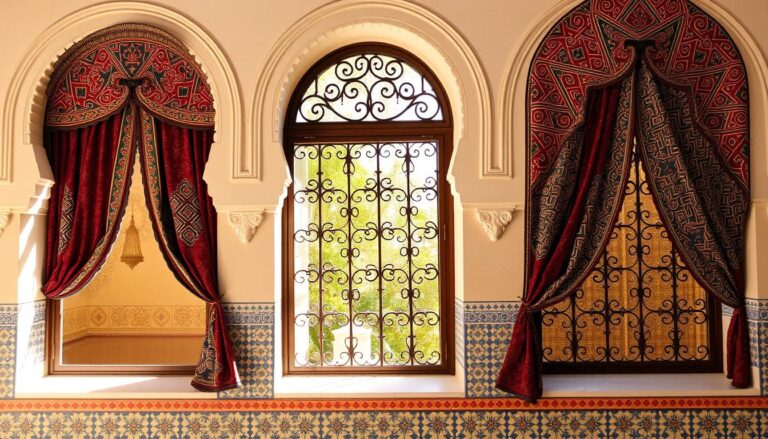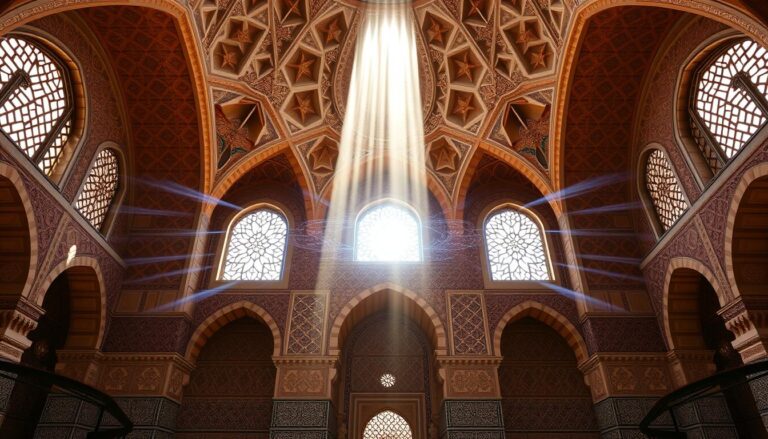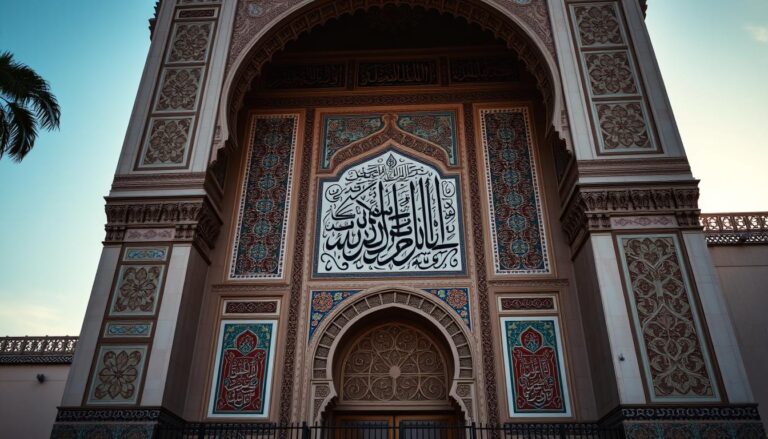Imagine walking through Marrakesh’s lively streets. Here, ancient Berber clay kasbahs meet Islamic-inspired minarets with stunning tiles. This mix of old and new is what makes Moroccan design special. It’s a blend of traditional and modern styles.
But what’s the story behind this unique look? How does it keep changing with new ideas?
Key Takeaways:
- Moroccan architecture showcases a rich fusion of Berber, Arab, and European influences
- Traditional Moorish elements, such as zellige tiles and ornate woodwork, are integrated with modern materials and construction techniques
- Color plays a vital role in unifying Moroccan cityscapes, blending warm earth tones with vibrant accents
- Architects like Driss Kettani are bridging the gap between tradition and modernity, emphasizing sustainability and public space
- The French Protectorate in Morocco left a lasting impact on the architectural landscape, shaping the country’s distinct identity
Clashes of Cultures in Moroccan Architecture
Moroccan architecture is a captivating tapestry, woven with threads from diverse cultural influences. The Berber clans, Morocco’s indigenous people, have left an indelible mark with their simple, earthy designs. They use local materials like clay, mud, stone, and palm wood to build durable, functional structures.
Traditional Amazigh and Arab Influences
The arrival of Islam in the 7th century introduced intricate geometric patterns and Quranic calligraphy. These elements have become hallmarks of Moroccan design. During the Moorish period, the iconic horseshoe arch and ornate cusped arch emerged. They blended seamlessly with the Berber aesthetic.
European Colonial Architectural Styles
The French colonization of South Morocco (1912-1956) brought new design influences. Features like large windows and strict building codes were introduced. This fusion of European layouts and traditional Moroccan aesthetics gave rise to the Mauresque or Neo-Moorish style. It is evident in the architecture of cities like Rabat and Casablanca, which showcase a harmonious blend of Art Nouveau and Art Deco influences.
“Moroccan architecture is a captivating tapestry, woven with threads from diverse cultural influences.”
The resilience and adaptability of Moroccan architecture are a testament to the enduring power of cultural exchange. From the Berber’s earthy simplicity to the Moorish grandeur and the European colonial elegance, this architectural landscape has evolved. It has created a unique and mesmerizing fusion, reflecting the rich cultural heritage of Morocco.
Fusion of Modern-Traditional Designs in Moroccan Architecture
Moroccan architecture beautifully mixes colors in Moroccan architecture and materials in Moroccan architecture. This creates a stunning blend of new and old. The bright colors of Moroccan cities, like green rooftops and blue walls, bring people together. They also add a spiritual feel to the area.
The use of traditional materials like clay and stone, along with new ones, makes a perfect mix. This balance shows the beauty of both old and new.
Contemporary fusion and modern ethnic design are becoming more popular. They work well with Morocco’s rich history. Designers use old designs like arches and zellige tiles with new materials. This creates a beautiful mix of old and new.
Contemporary Interpretations of Traditional Elements
Moroccan architecture’s rich history inspires new designs. Designers update classic styles for today’s tastes. They also use new materials in Moroccan architecture and sustainable designs.
“The fusion of modernity and tradition results in harmonious and aesthetically captivating spaces.”
Moroccan designers find a balance between colors in Moroccan architecture and materials in Moroccan architecture. This creates a contemporary fusion that looks to the past and future. It makes Moroccan architecture truly special and eye-catching.
Vernacular Architecture and Sustainable Building Practices
In Morocco, vernacular architecture focuses on local needs and resources. Architects like Driss Kettani and Salima Naji lead this movement. They aim to respect traditional techniques and promote sustainable building practices.
These architects learn from Moroccan villagers’ wisdom. They use local materials and focus on passive cooling and heating. This approach honors the cultural heritage of the built environment.
“Vernacular architecture is not just about aesthetics; it’s about creating buildings that are in harmony with their surroundings and the needs of the people who inhabit them.”
In Morocco, you can see the impact of vernacular architecture. Traditional courtyard designs and natural ventilation are common. Materials like rammed earth and local stone are used, blending beauty with sustainability.
By mixing old and new, these architects preserve Morocco’s architectural legacy. They also create a sustainable future where culture and environment are united.
Integrating Traditional Techniques for Climate Control
Moroccan architecture uses old ways to control the climate, showing a green way to fight the heat. Thick, earthen walls and zellige tiles keep places cool during the day and warm at night. This helps keep the inside of homes comfortable.
Thick Walls and Zellige Tiles for Insulation
Thick walls and zellige tiles are old tricks for keeping homes at the right temperature. These materials soak up heat during the day, keeping it out of homes. Then, they slowly give off warmth at night, making homes cozy.
This way of cooling doesn’t need lots of energy like air conditioning does. It makes Moroccan buildings a great example of green design.
Riads and Natural Ventilation for Cooling
Riads, traditional houses with open courtyards, are key to Moroccan cooling. The open space lets in cool air and helps cool down homes. Many riads have water features or small pools that cool the air through evaporation.
Windows with special screens also help control the temperature. These screens let in air but keep out heat, making homes more comfortable.
“Studies have shown that well-designed natural ventilation systems in Moroccan homes can reduce cooling energy use by up to 50% compared to those reliant on air conditioning.”
Moroccan architecture combines traditional techniques for climate control, passive cooling methods, riad design, and natural ventilation. It sets a high standard for green and energy-saving buildings that still work today.
Materials and Methods for Eco-Friendly Construction
Moroccan architecture has always been about building sustainably. It uses eco-friendly materials and follows passive solar design. Mud bricks are a key example. Made from clay, sand, and sometimes plants, they are a green alternative to concrete and steel.
These bricks are great at keeping temperatures stable. This means they help cut down on the need for heating and cooling.
Mud Bricks and Passive Solar Design
Moroccan builders are experts in passive solar design. They place windows and use materials that absorb and store warmth in winter. But they block it in summer.
This design reduces the need for air conditioning and heating. It makes Moroccan buildings a model for green construction.
“Moroccan architecture has long been a testament to the power of sustainable design, seamlessly blending traditional building techniques with modern eco-friendly principles.”
Moroccan builders use eco-friendly construction materials like mud bricks. They also use passive solar design. This shows the way to a greener future in architecture.
By mixing old traditions with new needs, Moroccan architects inspire us. They show how green design can change the world.
Evolving Moroccan Design through Cultural Blending
Moroccan architecture is a mix of cultures, blending Berber traditions, Islamic legacy, and Andalusian art. This mix has created a unique design that attracts people worldwide.
Influences from Berber, Arab, and Andalusian Styles
The Berber people’s designs focus on natural materials and blending with the landscape. Islamic culture brought geometric patterns and zellige tilework. Andalusian influence added ornate plasterwork and tile designs.
These influences have merged over time, creating a Moroccan style that’s both old and new. The use of colors like terracotta, blues, and greens is inspired by nature. Intricate patterns and textures, like handwoven rugs and carved wood, add depth and warmth.
Today, Moroccan design combines tradition and modernity. Architects and designers use local elements with new styles. This is seen in riad homes, hotels, and resorts across the country, inspiring people everywhere.
Contemporary Moroccan Architecture Projects
Traditional Moroccan architecture is famous worldwide. But, the country’s modern design scene is just as exciting. The Grand Theater of Rabat, designed by Zaha Hadid, is a prime example.
Grand Theater of Rabat by Zaha Hadid
The Grand Theater of Rabat has a unique, flowing shape. It’s inspired by the Bouregreg River and includes traditional muqarnas vaults. King Mohammed VI commissioned it to modernize Rabat and link it with Salé.
This project shows Zaha Hadid’s style, mixing modern forms with Moroccan heritage. It’s a key example of contemporary Moroccan architecture projects.
“The fluid, sculptural form of the theater is described as taking its energy from the Bouregreg River, while incorporating traditional elements like muqarnas vaults in the main auditorium.”
Morocco is blending modern and traditional styles. The Grand Theater of Rabat is a standout piece of contemporary Moroccan architecture. It has caught the world’s eye.
Conclusion
Moroccan architecture shows the nation’s rich cultural history. It mixes old influences with timeless ideas. Its detailed designs, useful parts, and deep meanings show Morocco’s past, present, and future.
Modern buildings are also rising, but they blend well with the old heritage. This mix makes Morocco’s beauty even more special. The architecture is a lively way to show who Morocco is and how it has overcome challenges.
The Hassan II Mosque in Casablanca and the Koutoubia Mosque in Marrakech are just a few examples. Moroccan architecture combines Amazigh, Arab, and European styles. This mix creates a lively and varied building scene.
Modern buildings fit right in with this rich history. They keep the country’s unique look alive while adding new touches.
Sustainable building is a big part of Moroccan architecture. Using mud bricks and passive solar design shows the country cares about the environment. Traditional methods like thick walls and zellige tiles help control the climate.
This focus on green building and saving energy inspires architects everywhere. It shows how Morocco’s architecture is not just beautiful but also smart and caring for the planet.
Source Links
- An Exploration of Modern Moroccan Architecture – The Yale Globalist
- Moroccan Art and Architecture, Traditional & Modern Styles
- Moroccan architecture
- Cultural Fusion in Design: Blending Language and Interior Aesthetics
- Exploring the Richness of Moroccan Architecture – Cindrebay
- The Timeless Design of Moroccan Homes
- Interior’Ar’s Approach to Cultural Design in Tangier, Morocco – interiorar
- Environmental and socio-cultural transition from traditional courtyard dwellings to contemporary housing practices in Morocco: insights from Arab and East Asian regions – Journal of Umm Al-Qura University for Engineering and Architecture
- Heritage of Modern Architecture in Morocco
- Discover the Spellbinding Morocco Architecture Masterpieces – Beauty Queen 91
- 101 World’s Best Modern Architecture Buildings – Neuroject
- Cultural Aesthetics: Architecture Techniques | Vaia
- ISVS e-journal, Vol. 1, no.1,
- Moroccan Zellige Mosaic Tiles with a Modern Twist! – 15 Pattern Ideas – MEC – Bespoke Luxury Mosaics
- Cultural Heritage of Zellij in Moroccan Architecture | Paris Tile
- Moroccan Majesty: Exotic Cultural Influences Reimagined – SofaSpectacular
- Modern Morocco: A Fusion of Tradition & Contemporary Tourism
- Corners of the Art World: Morocco
- These 8 architectural masterpieces in Morocco will blow you away
- Islamic, Berber, and Modern Influences in Architecture of Marrakesh
- news: merrett houmøller architects renovate a london home with a contemporary moroccan touch | the design story
- Moroccan Architecture – Planet Marrakech
- Exploring the Classic Elegance of Moroccan Patterns and Ceramic Tiles – Siddhi Designer Tiles
- Discovering the Beautiful Architecture of Hassan II Mosque

The Editorial Team is a passionate group of Morocco enthusiasts dedicated to sharing the beauty, culture, and wonders of this captivating country. With diverse backgrounds and a deep love for travel, we strive to bring you engaging and informative content that inspires your Moroccan adventures. From uncovering hidden gems and sharing local insights to exploring mouthwatering cuisine and showcasing the vibrant lifestyle, our team is committed to providing you with valuable resources and exciting stories that enhance your exploration of Morocco. Join us on this journey as we celebrate the rich heritage and unforgettable experiences that make Morocco truly special.

